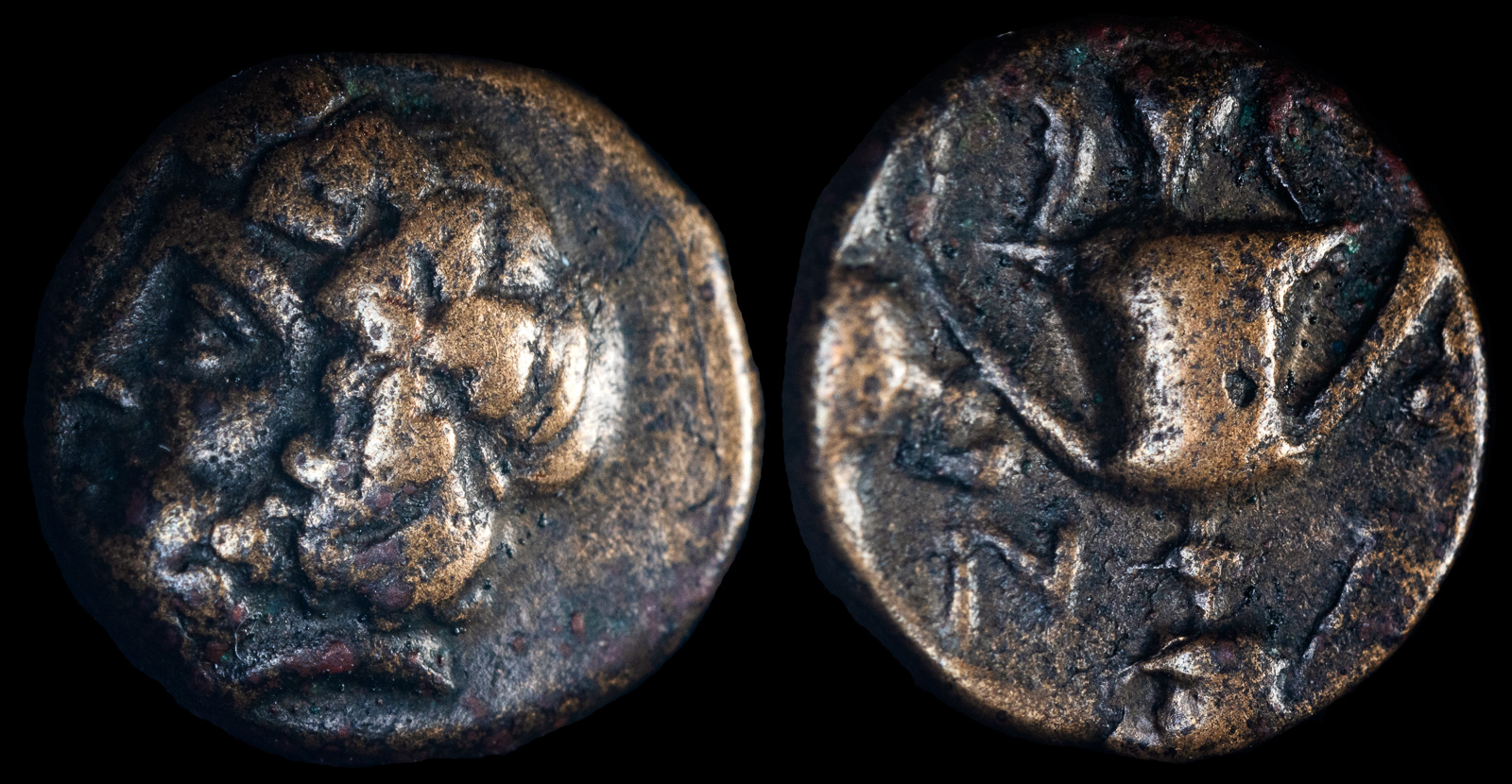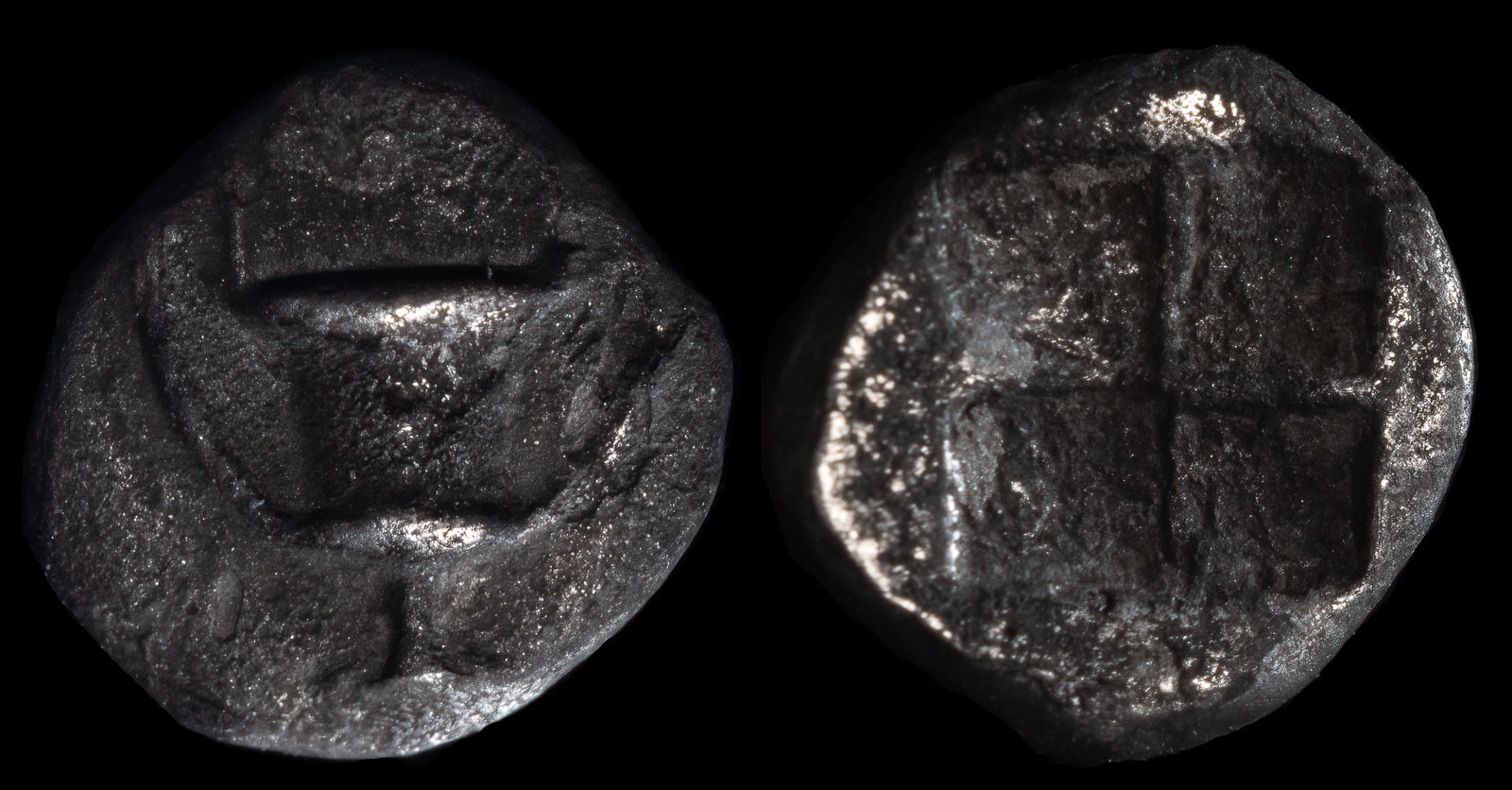
Naxos, Cyclades
4th century BCE
Æ 10.5mm, 1.45 g, 5h
Wreathed head of Dionysos left /
Kantharos with ivy leaves hanging from handles; grape bunch above.
Nicolet-Pierre, Naxos II, Canthare 1a, 1-6; HGC 6, 641
Ex Dr. Charles Schulz Collection
Ex CNG 2014.
Earlier this year when I was planning our trip to Greece, my wife told me we could visit any three Greek islands, so long as two of them were Santorini and Mykonos. With that freedom, I scoured the Greek islands for that perfect complement. One that I quickly latched onto was Naxos.
Naxos is the largest of the Cyclades and has a ton to explore, with beautiful mountain towns, each decorated in its own unique way, along with ancient ruins, it seemed the perfect spot for a few days. So, I made the proposal and it was rejected due to the island’s similarity to Mykonos and Santorini. When I stated that it was considerably different in activities and sights, I was shown the fine print where the contract clearly stated that the third island must not have white houses. So, I switched Naxos for Kefalonia and received her approval. In fairness, Kefalonia was stunning.
To my surprise, though, my tangle with Naxos was not complete. I paid no attention when I received an email that our fast ferry was swapped between Santorini and Mykonos because we were still getting there, and that’s something in Greece. What I didn’t notice was they added a stop.
Of course, my eyes piqued when we approached an island I knew was not Mykonos and I immediately grabbed my camera and took a few photos. I didn’t have long because the way Greek ferries work is you grab your bags and huddle by the door before it opens, then you make a mad dash to the island before they close the doors and move on to who knows where. It’s not just the ferry that’s fast. You need to be also.
But, I still managed some photos. It was midday and the light absolutely sucked. The overwhelming majority of my travel photos are taken in the early mornings or at sunset. So, I converted them to black and white.

Pictured above at the left is the entrance to the Temple of Apollo. It’s also called the Portara and was built in the 6th century BCE. Although the telephoto compression gives the appearance that the temple is in the center of the city, it’s not. It was actually built on a small islet connected to the mainland by a walkway. These days, I expect that it’s under assault from influencers.

Since I didn’t have a tour guide, I’m not entirely sure, but I think the castle is the Venetian Castle of Naxos. The Venetians built a number of stunning castles all around Greece, and the majority served little obstacle to the Ottomans. I’m a little iffy whether this is actually the castle, but there’s definitely a Venetian castle in the city.
Therefore, Naxos was certainly on my list for coins, and I was thrilled to pick one up recently!
I was initially intrigued by the provenance, but sadly neither Snoopy nor Woodstock ever saw this coin. It was a different Charles Schulz.
In the archaic times, Naxos was a major power. Herodotus labeled it as the richest of the Cyclades. Archeological evidence shows that neanderthals and then homo sapiens inhabited the island from 200,000 years ago. A species of dwarf elephant, standing only a meter high, also lived there until we humans arrived and eradicated them. The thought just hurts. Imagine a herd of little elephants wandering around? That would have been the cutest thing.
But moving onto things less cute, in 506 BCE, Aristagoras of Miletos convinced the Persian king that he would achieve untold riches by conquering Naxos, and thus led a siege that spectacularly failed. According to Herodotus, he therefore convinced the Ionians to revolt against the Persians because he didn’t want to face the repercussions. Most historians today seriously doubt that was the only (or even one of the) causes of the revolt, but that too didn’t end well.
In 490 BCE, as part of the Ionian revolt, the Persians finally destroyed Naxos and its days as a major power ended. In 469 BCE, when they tried to leave the Delian League, Athens punished them severely. They remove their navy, settled 1000 cleruchs, and increased their tribute.
Not surprisingly, by 377 BCE Naxos was allied with Sparta against Athens and it was between Naxos and Paros that Athens defeated the combined fleet. This coin may have been minted around that time.
However, the above history belies the importance Naxos had to the Greeks. Zeus himself was raised in a cave here, back when the island was called Dia. To think that some of his toy trucks and cars may be lurking under the dirt here is shuddering. In some myths, Dionysos also grew up there. He remained the most popular god on the island, hence his depiction on my coin.
What Naxos is most famous for, partially thanks to Richard Strauss, is the abandonment of Ariadne. There are many, many, conflicting versions of this myth, but they mostly start with Ariadne as a princess in Knossos (Crete). There, King Minos ran the very first Hunger Games by requiring Athens to commit seven men and women who would be devoured by the Minotaur. Finally, their king Theseus volunteered to kill the beast.
When Ariadne saw Theseus, she immediately fell in love with him. Since his most pressing concern was not dying, she offered him a sword and an IPad with an interactive map of the labyrinth. However, remember that this was roughly 1500 BCE and a rough-hewn Athenian king could no more use an IPad than we could recite Homeric Greek, so she settled on a string so he could find his way back.
Obviously Minos wasn’t pleased about this, so Theseus grabbed Ariadne on the way out of town. To her dismay, he then left her on Naxos. Again, the stories here differ, but some Athenian legends state she died of grief.
Now, you need to remember that ancient Athens was about the least gender balanced place in the ancient world back then. While elsewhere in the Greek world women at times played crucial roles, they were pretty much derided and shoved to the side in Athens. So, it comes to no surprise that there are other myths where she most definitely didn’t die of grief, but instead upgraded.
In Naxos, she met Dionysos, who couldn’t understand what Theseus was thinking (in some versions, Dionysos posed Theseus no option) and he married and fathered several children with her.
Unfortunately, later on some prick named Perseus came by, held up the head of Medusa, and turned Ariadne to stone. Seriously, there should be warning labels on these things. But, in some versions it ends happily because Dionysos headed down to Hades with some full cases of premier grand cru Bordeaux, and the matter was settled so she could ascend.
Regardless, I’m happy to have a coin from Naxos and some photos. Now I just need to actually go there.

“Cyclades, Naxos
AR Tetartemorion 5mm .12g
520-470 BCE
Obv: Kantharos
Rev: Quadripartite incuse square
HGC 6, 627″
Archilochos compared the Naxian wine to nectar. Eubolos wrote “Naxian almonds were mentioned by the ancients. And I am convinced, he says, that particularly good ones are producted on the island of Naxos.”
Eupolos wrote “Give me some Naxian almonds to chew on, and some wine from Naxian vines to drink!”
Approximate time when Polykrates becomes tyrant of Samos. He is supported by Lygdamis of Naxos.
Persian forces attempt to take Naxos, but are unsuccessful.
Naxos attempts to leave the Delian League and are severely punished by Athens.
Eresos, Byzantion, Chios,Mytilene, Methymna, Rhodes, Thebes, Korkyra, Eretria, Kios, Samos, Naxos, Andros, Myrina (Lembos), Hephaistia, Imbros, and Thasos join the Second Athenian League, reaffirming its alliance with Athens in response to the growing threat of Persian interference and internal Greek conflicts.
Naxos comes under Roman rule, who use it as a place of exile.